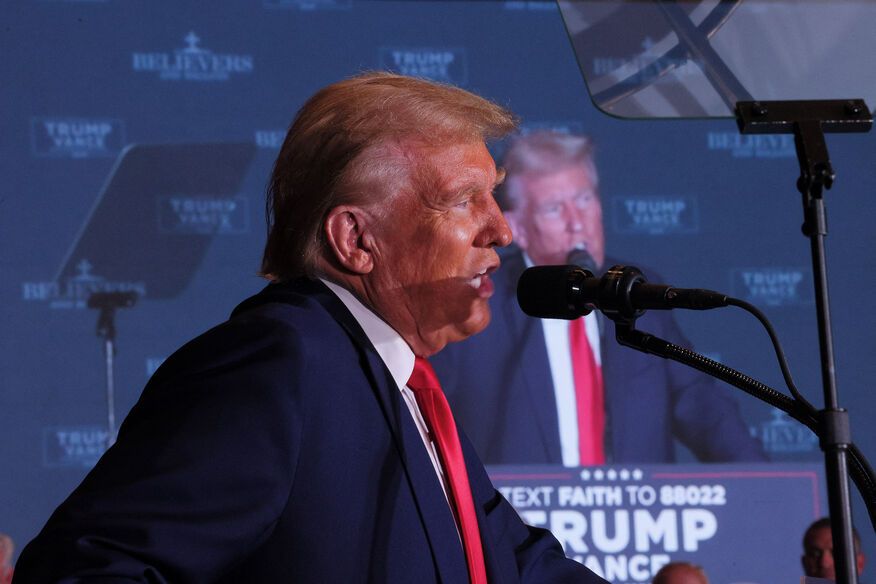US Presidential Election: Here’s Why Stocks, The US Dollar, Bitcoin and Bond Yields Are Moving

Insights - The US Presidential election has taken place on Tuesday (5 November) and votes are continuing to be counted.
However, according to exit polls, it seems extremely likely that former President Trump will defeat current Vice President Kamala Harris to clinch the White House. That’s mainly down to him having already won two of the seven key swing states, and more could follow in his favour.
Along with a projected victory for Republicans in the Senate, investors are preparing for a “clean sweep” of two of the three “arms” of government – the Presidency and the Upper House of Congress (Senate) as the Republicans are also currently in control of the Lower House of Congress (House).
So, for investors, what has the projected Trump victory meant for markets and asset prices? It’s mainly impacted the stocks, the US Dollar, Bitcoin and bond yields, including so-called Trump Trades. Here’s why.
Market expecting a Trump victory
The broader stock market has been expecting a Trump victory in the election over the past few weeks. As a result, investors have positioned themselves for the Republican to take the Presidency. Given this, stock market index futures shot up when it became clear that Trump would win.
Many large investors have been “long” US stocks heading into the election and an official Trump victory being declared could see that positioning be rewarded with further gains.
Indeed, Trump is generally seen as “pro-market” by Wall Street – given his support of further significant corporate tax cuts – and S&P 500 Index futures are currently up by 1.9%, signalling a strong open to trading on Wednesday.
Elsewhere, the US dollar have popped higher and has posted its strongest gain against major currencies since 2020. His proposed steep trade tariffs against other countries and potential new corporate tax cuts would be inflationary. As a result, that could constrain the amount that the US Federal Reserve could cut interest rates.
Given this hypothetically tighter interest rate policy, investors have positioned themselves for a stronger US dollar pre-election and, as Trump now looks likely to win, that scenario has played out. Where the US Dollar heads in the medium to long term, though, is still up for debate as a potential second-term President Trump’s policies remain to be fleshed out.
Bitcoin and bonds react
One of the most-watched assets during the election has been cryptocurrencies and, by default, the price of Bitcoin. Trump is seen as “pro-Bitcoin” with his prior comments on the world of crypto and as Trump victories were projected in early swing states, the price of Bitcoin has surged.
Bitcoin was up by as much as 8% in Asia on Wednesday (6 November) but it has since pared some of those gains and is currently sitting at just under the US$73,700. The price of Bitcoin had risen over the past month in expectation of a Trump victory at the polls.
On the fixed income (bonds) side, bond yields jumped. The US 10-Year Treasury yield – often viewed as the de facto risk-free asset – saw its yield rise by 15 basis points and trade over 4.43%, its highest level since early July. Of course, since bond yields are inversely correlated to the price, that has meant that bonds have fallen in price.
That’s mainly down to market concerns that a Trump presidency – and perhaps a fully Republican-controlled Congress – could implement sweeping tax cuts and punitive trade tariffs. That would bring higher inflation and a rise in the US deficit, huge negatives for bond prices.
Full result could take days
A full result and counting of votes could come early as Wednesday night in the US but a potentially conclusive result could also come as late as Thursday or Friday.
Even so, assets have reacted to what most polls and projections are saying will be a Trump Presidency and Republican Congress. With two of these three arms of government under Republican control – with the Supreme Court being the third arm – then President Trump’s proposed reforms or tariffs could more easily be pushed through and written into law.
Regardless of the outcome, there is likely to be more volatility in the days ahead as financial markets get to grips with who’s the conclusive winner and what the longer-term implications will be for investors.
If the Fed were to become more concerned about an impending US recession, the pace of interest rate hikes could quicken but – if the US economy manages to avoid this “hard landing” scenario – then it could be a much more gradual path downwards for interest rates over the next 12-18 months.
* The content presented above, whether from a third party or not, is considered as general advice only. This article should not be construed as containing investment advice, investment recommendations, an offer of or solicitation for any transactions in financial instruments.

